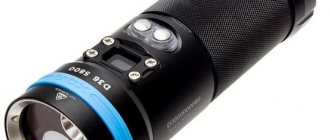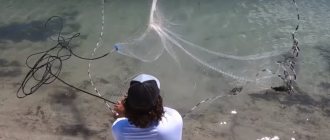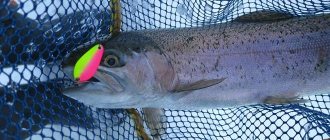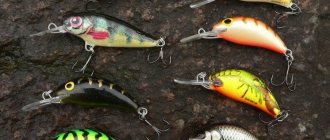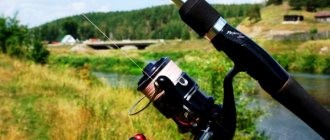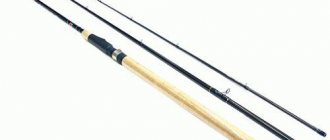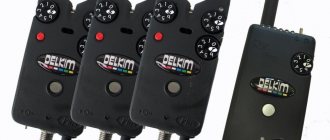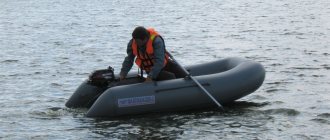It is difficult for a novice diver to choose the “right” equipment. To understand this, you need to have certain knowledge and experience. You can always find information on the Internet, but often it is presented by fellow divers and is therefore subjective. Thematic materials often contradict each other, which is confusing. The article below contains current requirements that one of the most important pieces of equipment – fins – must meet. When collecting materials, the experience of professionals was taken into account.
Material of manufacture
Fins are made from the following materials:
- plastic;
- fiberglass;
- composite of a fiberglass base and a top layer of carbon (sandwich carbon);
- carbon
The materials are listed in order of increasing swimming characteristics and, accordingly, cost:
- plastic – up to $30;
- fiberglass – up to $60;
- composite – up to $100;
- carbon - up to $600.
To be fair, it should be noted that plastic fins can be found at the same price as composite ones. Since the cost is also influenced by other factors, which we will consider below.
Plastic models have the lowest efficiency of all materials, which is explained by its physical characteristics. Fiberglass exhibits greater elasticity and is a more natural “extension” of the leg. The use of carbon adds lightness to elasticity, which further increases the efficiency of the underwater hunter’s movement. The exclusively carbon blades are so light that they are practically unnoticeable when moving.
Design features
To reduce the load under water and make swimming easier, manufacturers add certain design features to their models. They can be found in models in combined form or separately.
Flow Laminarizer
Models with a flow laminarizer have holes, slots or slits on their blades that allow, when swimming, to balance the pressure on opposite sides of the fin blades and reduce the load created by vortex water flows when moving.
Tunnel effect
To reduce the load on your legs under water, you need to direct its flow in the right direction. This can be achieved if the blades of the fins bend and create a tunnel for the flow of water. For these purposes, the middle of the fins is made of a softer material, and the sides are made of a hard one.
Length
A large length - 75 cm or more - is traditionally necessary for situations where speed development is required. This applies primarily to divers. Can be useful for deep sea hunting. More force is required to move in such fins.
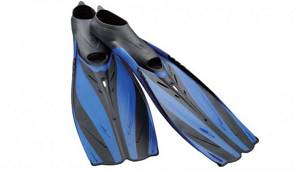
For most midland hunters diving into lakes and rivers, fins that are too long are not needed. Speed is not very important. But maneuverability when hunting is required. For better maneuverability, choose small and medium models – up to 65 cm in length.
How to choose fins for spearfishing: advice from professionals
Experienced hunters and divers advise:
- The rigidity of models can be determined by their color: the darker they are, the more rigid they are.
- For beginners, it is best to purchase shorter options, and each subsequent fins should be longer than the previous ones. Otherwise, it will be more difficult to get used to the new thing.
- When putting on fins, they should fit snugly along the entire length of the foot and not “loop around”.
- For underwater hunting, you should not choose options shorter than 0.7 m.
- Before hunting, you should definitely try out new fins in a comfortable environment, such as a swimming pool.
The right choice of fins will allow you to comfortably stay in the water for a long time without surfacing and spend less energy, which means hunting more efficiently. Therefore, the choice of this equipment should be given a lot of attention. Models in which the heel is closed and have the ability to change blades are considered a good option for hunting. This design will allow you to adapt the fins to different conditions and feel comfortable.
Open or closed heel
Despite the fact that all spearfishing enthusiasts prefer fins with a closed heel, the question of which is better remains a matter of debate.
The advantages of a closed heel are obvious:
- such fins sit more stable on the leg;
- There is no risk of the straps and fastenings of the fins getting caught on grass, reeds, nets and other underwater obstacles.
There is also a minus: options with a closed heel require precise selection of the size. This is not a problem if you always hunt in the same conditions. You buy some fins (or galoshes) and use them.
But if you want, for example, to hunt in late autumn or winter, when you will be wearing thick socks and boots, which give an additional about 1 cm to the size of your feet, but summer fins, which should fit tightly on your feet, will no longer be suitable.
Pros of galoshes with open heels:
- have great variability in leg size - a size fluctuation of 1-2 cm will not be critical;
- can be used both with and without bots;
- the strap secures the leg firmly enough;
- the probability of losing such a fin is no greater than being thrown out of completely closed galoshes;
- they are more compact and lighter.
Don't treat fins with adjustable heels like a child's toy. The well-known manufacturer of fins for spearfishing - MARES - has in its assortment a couple of dozen compact (40-50 cm) models with an open heel.

They are all high-tech products that incorporate innovative ideas to make scuba diving more economical and efficient.
For example, in some models, a soft rubber insert is made in the middle of the blade, which acts as a membrane between the toes of amphibians, creates a more powerful flow of water and puts less strain on the legs.
In terms of price, fins with an open heel are often superior to classic closed versions. The already mentioned open Mares models made of plastic and rubber cost $100-$200, which is quite comparable to the cost of fiberglass and composite products.
Main criteria for choosing fins
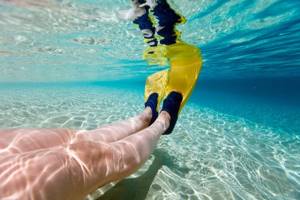
Having decided on a specific type of fins suitable for use in a particular situation, you should pay close attention to their technical characteristics. They provide the proper degree of comfort during operation and directly affect functionality.
Design of the seat - galoshes
- The closed heel ensures the most reliable and tight fit of the fin on the leg; with this design, the fin does not play or dangle during intense swimming. This design requires careful selection of fins, taking into account the thickness of the thermal socks used (if any are used); it will not be possible to purchase such fins for growth. It is considered the best option for spearfishing and diving;
- An open heel, which is adjusted using a special rubber tie, is the best option for amateur use and snorkeling. The design is universal, with its help you can adjust the fins to any foot size. You have to pay for versatility with insufficiently rigid fixation and the possibility of losing the fins when caught on underwater objects;
- The third type of design is monofins. This is a highly specialized instrument, used exclusively for acrobatic and sports purposes, it makes it possible to develop significant speed. The monofin consists of one wide blade driven by both legs. The monofins are fixed on the legs using soft rubber stockings.
Material from which the fin blade is made
The seat, the so-called galosh, is always made of high-strength rubber. The blade can have a different design and be made of the following materials:
- Rubber. Fins with a rubber blade can be monolithic, or they can differ in their physical parameters. The most budget option, perfect for amateur use;
- Plastic. A more advanced material used to create fins in the mid-price range;
- Carbon fiber, or carbon, is today considered the lightest, most functional and comfortable material; the most technically advanced and, accordingly, expensive fins are made from it.
Fins stiffness
Directly affects the speed of movement under water, as well as the weight and physical dimensions of the swimmer. The more prepared and stronger the latter, the more rigid the fins should be. On the contrary, soft fins are perfect for beginners just learning to swim with equipment.
How to choose fin size?
Depending on the size of the working blade of the fins, their physical properties and applicability in certain conditions are determined.
- Long fins (100 centimeters or more) are used for diving, spearfishing and deep-sea scuba diving;
- Fins of medium length (70-90 centimeters) are considered universal, they are suitable for both classic diving and spearfishing;
- Short fins (no more than 60-70 centimeters) are an excellent option for snorkeling and active summer recreation on the water;
Choosing fins for the sea
Sea holidays almost always involve deep-sea diving - even at a depth of 5-7 meters, sea water amazes with its crystal clearness. For these purposes, fairly long, about 70-90 centimeters, fins with blades made of plastic are best suited. The design should include paddles and laminators for rapid descent and ascent. The heel design is open, allowing it to be adjusted to the diver’s foot size.
Choosing fins for spearfishing
Underwater hunting requires the use of special hunting fins with a length of 90-110 centimeters. Their design involves a closed heel and a special, composite fin design made of several materials of varying hardness. Their blade is deflected from the horizontal position at an angle of about 15 degrees to ensure the fastest and most productive penetration.
Choosing fins for the pool
For the pool, the best option would be compact snorkeling fins with an open heel and small dimensions, about 50-70 centimeters. Blade material: rubber or plastic. However, the above example is not suitable for those who go to the pool to purposefully practice swimming and diving techniques. In this case, you should use your main fins, which the diver uses when diving or spearfishing.
How to choose fins for a child
Children's fins are selected individually for each child. The fin size is compact, about 50-60 centimeters, the heel design is open. After the child learns how to handle them, you can look towards more specialized models.
How to choose fins for diving and snorkeling
Despite their similarities, diving and snorkeling fins have different features. If for diving it is necessary to give preference to long and powerful models made of plastic or carbon fiber, then snorkelers can easily get by with compact fins with a blade 60-80 centimeters long and an open heel. Of course, no one prohibits the use of short fins for diving and vice versa, but it is unlikely that functionality will be ensured in this case.
Convenience of galoshes
It’s like with shoes: they should be comfortable, they shouldn’t be too tight or loose on the foot. It should be taken into account that you may have to hunt in different climatic conditions, in which you will need to additionally insulate your legs and, accordingly, increase the size. If we talk about hunting in cold water, it is better to choose overshoes made of thermal rubber, which provide additional warmth to the feet.
To avoid slipping on stones and other poorly traction surfaces, you need to choose galoshes with a ribbed sole, “with a pattern.” Not all models are equipped with such soles.
About the relevance of choice
If you choose the right fins for spearfishing, the swimmer will not need to expend a lot of energy while moving underwater. Consequently, he will not need to frequently swim to the surface for a new portion of air. If the fins have low efficiency, then, as experts say, some of the energy will definitely be lost and underwater maneuvers will not be as effective as we would like. Depending on the design features and material, several types of fins are presented to consumers.
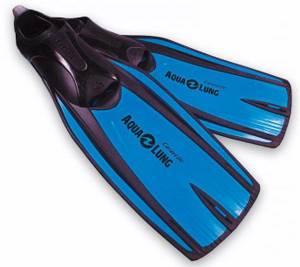
The best fins for swimming
It is difficult for beginners to choose the right fins on their own the first time. Determining the required set of qualities and individual technical properties comes with experience. Therefore, we recommend that you get acquainted with some of the best fin models:
- Speedo Biofuse Training Fin - a famous brand with well-deserved respect, fins are made using unique technologies. The price is around 4000 rubles.
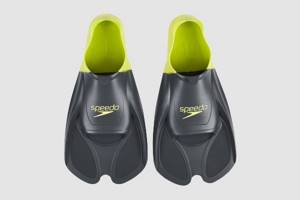
- Arena Powerfin - the optimal choice for beginner swimmers. Price from 2800 rub.
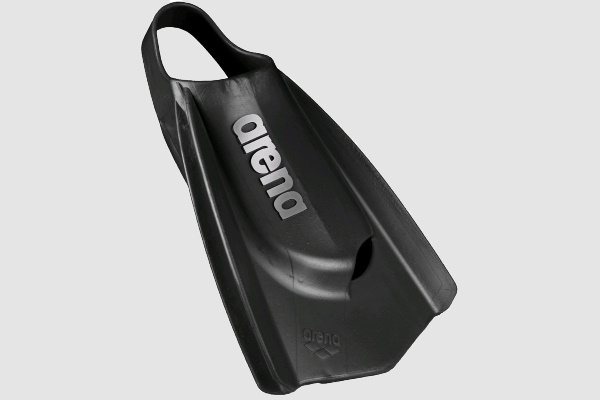
- TUSA Sport UF-21 —Various purposes of use and a wide range of sizes make the model universal. Price from 2300 rub.
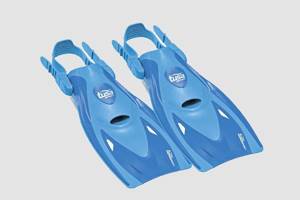
- Colton CF-01 - inexpensive silicone fins with excellent characteristics. The price is around 1300-1500 rubles.

- OMER Stingray long fins for diving and underwater adventures. They deserve the love of professionals and beginners. They have a blade change function. Price 8240 rub.
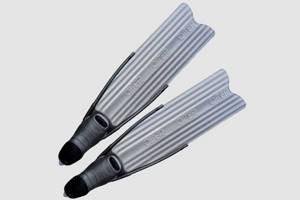
- Aqua Lung Caravelle - professional purpose, optimal ratio of quality characteristics and price category. Price from 3150 rub.

Fins are an essential equipment for swimming in the pool or diving in the sea. The possibility and safety of its use depends on the characteristics and correct selection of the product. Take your fin purchase seriously by doing your research or seeking advice from a professional. Only this approach will allow you to enjoy swimming and achieve success in your studies without being distracted by discomfort.
Open heel fins for spearfishing
The design feature of such fins is that they have a pocket device for the foot. It is possible to secure the leg using straps that are freely adjustable. This type of fin is best chosen for diving and is considered the most effective and comfortable, as it wraps tightly around the leg, does not restrict movement and allows for quick maneuvers. A high rate of maneuverability is obtained due to the fact that the legs and fins feel like one whole. But when movements occur on the surface, the efficiency decreases sharply, the reason is the rigidity of the structure. During a dive, the ends of the belt get in the way and it is not possible to use open equipment, as your feet freeze.
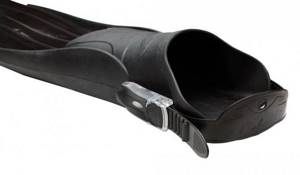
Types of fins
The market presents a wide range of inventory, differing in various parameters. The first thing that catches your eye when choosing is the length of the fins. They are:
- short;
- long;
- fused (monofin).
Let's look at the features of each type and the specifics of their application in more detail.
Short fins
These are rubber or plastic products, the length of which ranges from 50 to 65 cm. These fins are ideal for practicing in the pool or swimming in the sea. When choosing them, athletes rely not on developing speed, but on fine-tuning movements and maneuvers. This equipment helps you practice your body position in the water and hone the technical aspects of your swimming style.

Short rubber fins should be chosen for activities at shallow depths. They are convenient for doing various jumps and turns, somersaults and just swimming. For scuba diving, give preference to products with plastic blades.
Long fins
The length of the blades on such models can range from 60 to 90 cm. These products allow you to stay under water for a long time without wasting energy on unnecessary movements to hold and direct the body. For activities in the pool and sea swimming, choose the minimum length of the blades of this group of fins.

Beginners should not choose long fins, as swimming with them requires experience and training. By making a rash choice, you can not only become disappointed in swimming, but also cause yourself injuries and strains in your leg muscles, because the equipment puts increased physical stress on them.
The long blades are made of plastic. They provide good speed when moving underwater, but do not allow sudden maneuvers. Extra-long fins are ideal for divers, spearfishing enthusiasts, divers, and are indispensable for high-speed sport swimming.
Monofin
They are a fused form that combines both fins into one product. In appearance, the product resembles a fish tail fin. Monofins come in carbon and fiberglass.
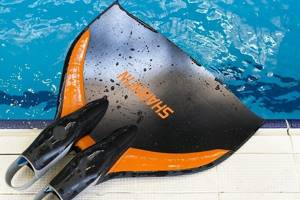
These fins are worn on both legs at the same time. Using this type of “fins” for beginners in swimming is life-threatening - it’s as if their legs are tied. You need to start exercising in the pool with this equipment under the guidance of a trainer and only if you know swimming techniques and have experience.
